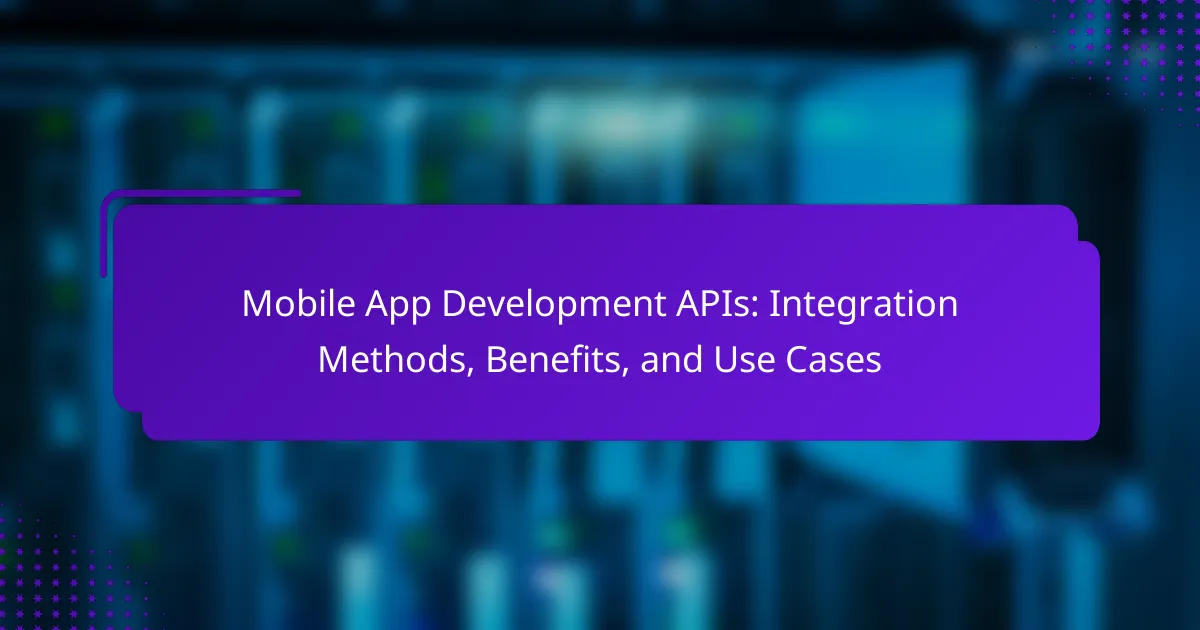Mobile App Development APIs are essential tools that enable developers to integrate various functionalities into mobile applications, enhancing user experience and streamlining the development process. This article covers the different integration methods for these APIs, including RESTful, SOAP, and GraphQL, each catering to specific development needs. It highlights the benefits of using APIs, such as time savings, scalability, and improved security, as well as common use cases like user authentication, payment processing, and data integration. By leveraging APIs, developers can create feature-rich applications that meet user demands efficiently.
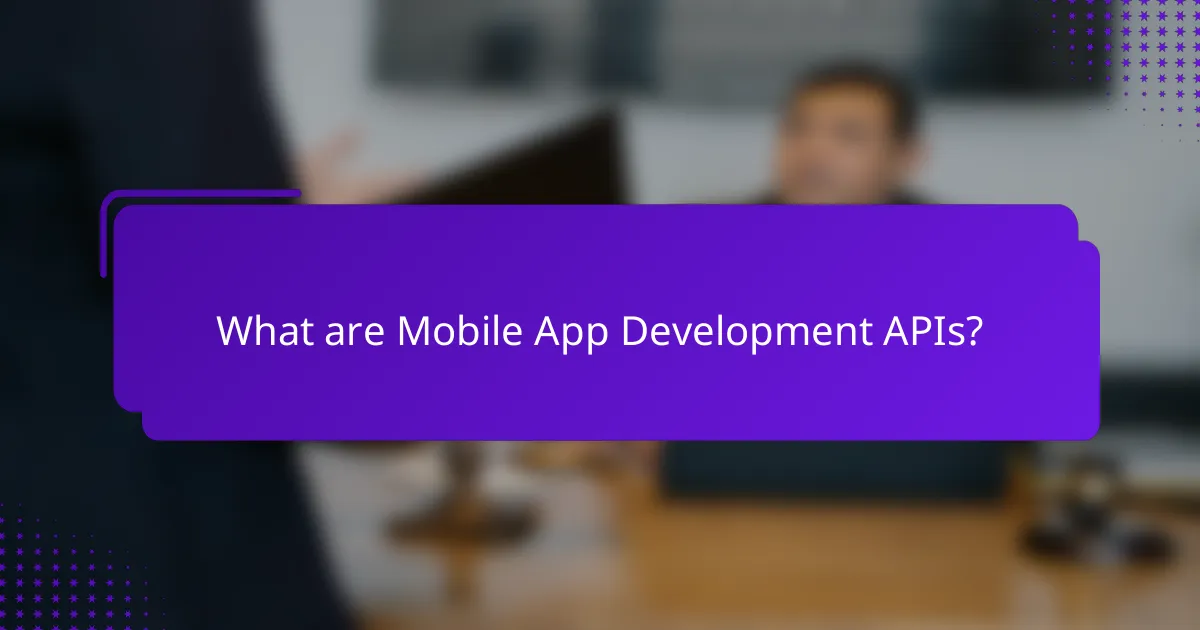
What are Mobile App Development APIs?
Mobile App Development APIs are application programming interfaces designed to facilitate the integration of various functionalities within mobile applications. They enable developers to access features and data from external services, libraries, or platforms. APIs streamline the development process by allowing developers to leverage existing technologies rather than building from scratch. They support functionalities such as payment processing, location services, and social media integration. For example, Google Maps API allows developers to embed maps into their applications. This integration enhances user experience and saves development time. APIs are essential for creating feature-rich, efficient mobile applications.
How do Mobile App Development APIs function?
Mobile App Development APIs function as intermediaries that allow applications to communicate with external services. They facilitate data exchange between the app and server, enabling functionality like user authentication and data retrieval. APIs define a set of rules and protocols for how software components should interact. This standardization allows developers to integrate third-party services seamlessly. For instance, a weather app uses APIs to fetch real-time data from weather services. APIs can be RESTful or SOAP, with REST being more common due to its simplicity and efficiency. They often return data in formats like JSON or XML, which are easy for apps to parse and use. This functionality enhances app capabilities without requiring extensive backend development.
What are the key components of Mobile App Development APIs?
The key components of Mobile App Development APIs include endpoints, authentication, data formats, and versioning. Endpoints are specific URLs that allow apps to access resources. Authentication ensures that only authorized users can access the API. Data formats, such as JSON or XML, define how data is structured and exchanged. Versioning helps manage changes to the API without disrupting existing services. Each component plays a crucial role in ensuring seamless communication between mobile apps and backend services.
How do APIs facilitate communication between applications?
APIs facilitate communication between applications by providing a set of rules and protocols for data exchange. They enable different software systems to interact seamlessly. APIs define how requests for data are made and how responses are formatted. This standardization allows applications to share information without needing to know the internal workings of each other. For instance, a mobile app can request weather data from a remote server using an API. The server processes the request and sends back the data in a structured format, such as JSON. This process is efficient and reduces the complexity of integration. APIs also support various authentication methods, ensuring secure communication between applications.
What types of Mobile App Development APIs exist?
There are several types of Mobile App Development APIs. These include REST APIs, which use HTTP requests for communication. Another type is SOAP APIs, known for their protocol-based approach. GraphQL APIs allow clients to request specific data structures. SDK APIs provide developers with tools and libraries for app functionality. Additionally, WebSocket APIs enable real-time data exchange. Each type serves specific integration needs and enhances app capabilities. The diversity of APIs supports various functionalities in mobile applications.
What are the differences between REST and SOAP APIs?
REST and SOAP APIs differ in several key aspects. REST is an architectural style that uses standard HTTP methods like GET, POST, PUT, and DELETE. SOAP, on the other hand, is a protocol that relies on XML-based messaging. REST is stateless, meaning each request from a client contains all the information needed for processing. SOAP maintains a stateful operation, often requiring a session.
REST is generally easier to use and more flexible, supporting various data formats such as JSON and XML. SOAP strictly uses XML, which can make it more complex. REST APIs are typically faster due to their lightweight nature, while SOAP can provide more security features through WS-Security.
REST is more suitable for web services that require scalability and performance. SOAP is often preferred in enterprise environments where security and transactional reliability are priorities.
How do GraphQL APIs enhance data retrieval?
GraphQL APIs enhance data retrieval by allowing clients to request only the data they need. This reduces over-fetching and under-fetching of data. Clients can specify their requirements in a single query. This contrasts with REST APIs, which often require multiple endpoints. GraphQL also supports real-time updates through subscriptions. This enables applications to receive data changes instantly. Additionally, GraphQL APIs provide strong type systems. This improves data validation and enhances developer experience. Overall, these features lead to more efficient and flexible data interactions.
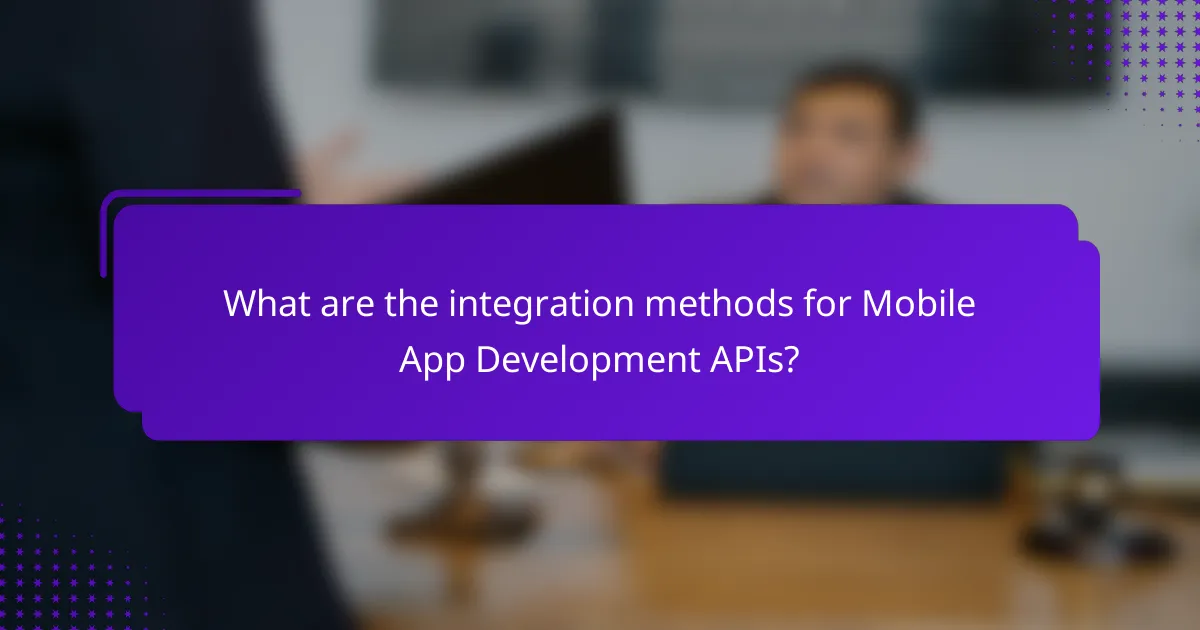
What are the integration methods for Mobile App Development APIs?
The integration methods for Mobile App Development APIs include RESTful APIs, SOAP APIs, and GraphQL APIs. RESTful APIs are widely used due to their simplicity and scalability. They utilize standard HTTP methods like GET, POST, PUT, and DELETE. SOAP APIs provide a protocol for exchanging structured information, often used in enterprise environments. GraphQL APIs allow clients to request specific data, enhancing efficiency by minimizing data transfer. Each method has its unique attributes, catering to different development needs and use cases. RESTful APIs are preferred for mobile apps due to their lightweight nature. SOAP APIs are chosen for applications requiring high security and transaction compliance. GraphQL is favored for applications needing flexible data retrieval.
How can developers integrate APIs into mobile applications?
Developers can integrate APIs into mobile applications by following a structured approach. First, they must select the appropriate API that meets the app’s requirements. Next, developers need to obtain an API key if required, which often involves signing up on the API provider’s platform. Then, they should read the API documentation thoroughly to understand the endpoints, request methods, and data formats.
After that, developers can use libraries or frameworks suitable for the mobile platform, such as Retrofit for Android or Alamofire for iOS, to facilitate API calls. They will construct HTTP requests based on the API specifications. Once the requests are made, developers handle the responses, which may involve parsing JSON or XML data.
Testing the integration is crucial to ensure functionality and performance. Developers can use tools like Postman to simulate API requests before implementing them in the app. Finally, they should monitor the API usage and handle any errors or exceptions that arise during the integration process.
What tools and frameworks assist in API integration?
Tools and frameworks that assist in API integration include Postman, Swagger, and Apache Camel. Postman is a popular tool for testing APIs, allowing developers to send requests and view responses easily. Swagger provides a framework for designing and documenting APIs, enhancing collaboration and understanding. Apache Camel is an integration framework that simplifies the process of connecting different systems through APIs. These tools streamline the integration process, making it more efficient and manageable for developers.
How does middleware play a role in API integration?
Middleware facilitates API integration by acting as an intermediary layer between different software applications. It enables communication and data exchange by translating requests and responses between APIs. Middleware can handle various protocols, ensuring compatibility across diverse systems. This reduces the complexity of direct API interactions. It also enhances security by managing authentication and access controls. Middleware often includes features for data transformation, allowing different data formats to be used seamlessly. Furthermore, it can provide logging and monitoring capabilities, which help in tracking API performance. Overall, middleware streamlines the integration process, making it more efficient and reliable.
What best practices should be followed for API integration?
Best practices for API integration include thorough documentation review and adherence to API specifications. Developers should ensure proper authentication and authorization to secure data access. They must implement error handling to manage unexpected responses effectively. Additionally, using version control helps maintain compatibility with future API updates. Testing APIs in a staging environment before production deployment is crucial. Monitoring API performance can identify bottlenecks and improve user experience. Following these practices leads to smoother integration and enhances application reliability.
How can developers ensure security during API integration?
Developers can ensure security during API integration by implementing authentication and authorization protocols. These protocols, such as OAuth and API keys, restrict access to authorized users only. Regularly updating and patching APIs is essential to protect against vulnerabilities. Employing HTTPS ensures secure data transmission between the client and server. Additionally, input validation prevents injection attacks by sanitizing user inputs. Implementing rate limiting protects APIs from abuse by controlling the number of requests from a single user. Monitoring and logging API activity helps detect and respond to suspicious behavior. According to the OWASP API Security Top 10, these practices significantly reduce security risks associated with API integration.
What are the common pitfalls to avoid in API integration?
Common pitfalls to avoid in API integration include inadequate documentation, which can lead to misunderstandings of functionality. Poor error handling is another issue, as it may cause failures to go unnoticed. Lack of version control can result in compatibility problems when APIs are updated. Additionally, not considering rate limits can lead to service disruptions. Neglecting security measures can expose sensitive data to vulnerabilities. Failing to test thoroughly may result in unforeseen bugs post-launch. Lastly, overlooking user experience can diminish the effectiveness of API integration in the application.
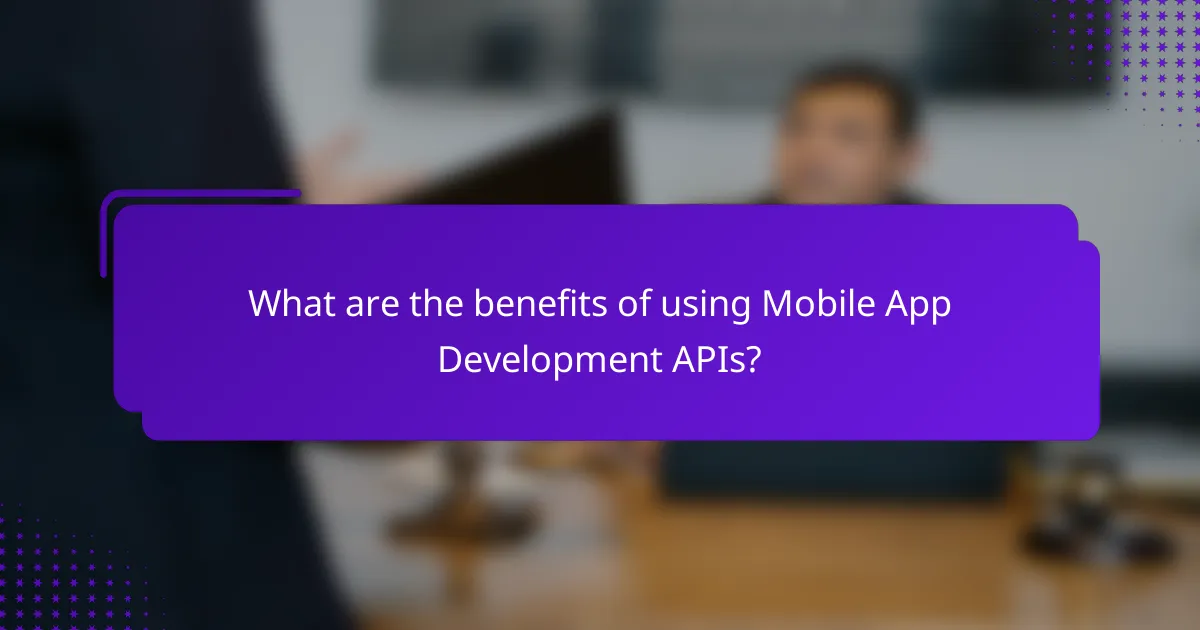
What are the benefits of using Mobile App Development APIs?
Mobile App Development APIs offer several benefits. They facilitate seamless integration of third-party services. This integration enhances app functionality and user experience. APIs allow developers to save time by reusing existing services. They enable access to data and features without building from scratch. APIs also support scalability, allowing apps to grow as user demands increase. Security is improved as APIs often come with built-in authentication measures. Additionally, they foster innovation by enabling developers to leverage new technologies easily. Overall, APIs significantly streamline the mobile app development process.
How do APIs enhance app functionality?
APIs enhance app functionality by enabling seamless communication between different software systems. They allow apps to access external data and services, which expands their capabilities. For instance, a weather app can use a weather API to provide real-time forecasts. This integration improves user experience by delivering timely and relevant information. APIs also facilitate third-party service integration, such as payment processing or social media sharing. According to a study by ProgrammableWeb, over 60% of developers use APIs to accelerate app development. This reliance on APIs demonstrates their critical role in modern app functionality.
What are the cost-saving benefits of using APIs?
APIs provide significant cost-saving benefits for businesses. They enable faster development by allowing developers to leverage existing services. This reduces the time and resources needed to build features from scratch. APIs also facilitate easier integration with third-party services, minimizing the need for extensive custom coding.
According to a study by MuleSoft, 83% of IT leaders reported that APIs helped them reduce development costs. By streamlining workflows, APIs can lower operational expenses. They also promote scalability, allowing companies to adapt without major financial investments. Overall, APIs lead to more efficient use of resources, translating to substantial cost savings.
How do APIs improve user experience in mobile applications?
APIs enhance user experience in mobile applications by facilitating seamless data exchange. They enable applications to access external services and data sources efficiently. For instance, APIs allow apps to integrate social media sharing features. This integration simplifies user interactions and enhances engagement. Moreover, APIs can provide real-time data updates, improving app responsiveness. According to studies, 70% of mobile app users prefer apps that offer personalized experiences. APIs support personalization by allowing apps to tailor content based on user preferences. Overall, APIs are crucial for creating dynamic, user-friendly mobile applications.
Which industries benefit most from Mobile App Development APIs?
The industries that benefit most from Mobile App Development APIs include healthcare, finance, retail, and entertainment. Healthcare organizations utilize APIs for patient data management and telemedicine applications. Financial institutions leverage APIs for secure transactions and real-time data access. Retail businesses use APIs to enhance customer experiences through personalized services and inventory management. The entertainment sector employs APIs for content delivery and user engagement. These industries demonstrate significant reliance on APIs to streamline operations and improve user experiences.
How do APIs drive innovation in healthcare applications?
APIs drive innovation in healthcare applications by enabling seamless data exchange between systems. They allow different software applications to communicate effectively. This integration enhances interoperability among electronic health records, telemedicine platforms, and wearable devices. Improved data sharing leads to better patient outcomes and personalized care. For instance, APIs can connect patient data from various sources, providing a comprehensive view for healthcare providers. According to a 2021 report by the Office of the National Coordinator for Health Information Technology, 86% of healthcare organizations utilize APIs for enhanced data access. This statistic underscores the growing reliance on APIs to foster innovation in healthcare.
What role do APIs play in e-commerce solutions?
APIs facilitate communication between different software systems in e-commerce solutions. They enable seamless integration of various services, such as payment gateways, inventory management, and customer relationship management. APIs allow e-commerce platforms to access external functionalities without building them from scratch. This reduces development time and costs significantly. For instance, using a payment API can streamline transactions securely. According to a report by Statista, 57% of online retailers utilize APIs for enhanced functionality. Therefore, APIs are essential for creating efficient and scalable e-commerce solutions.
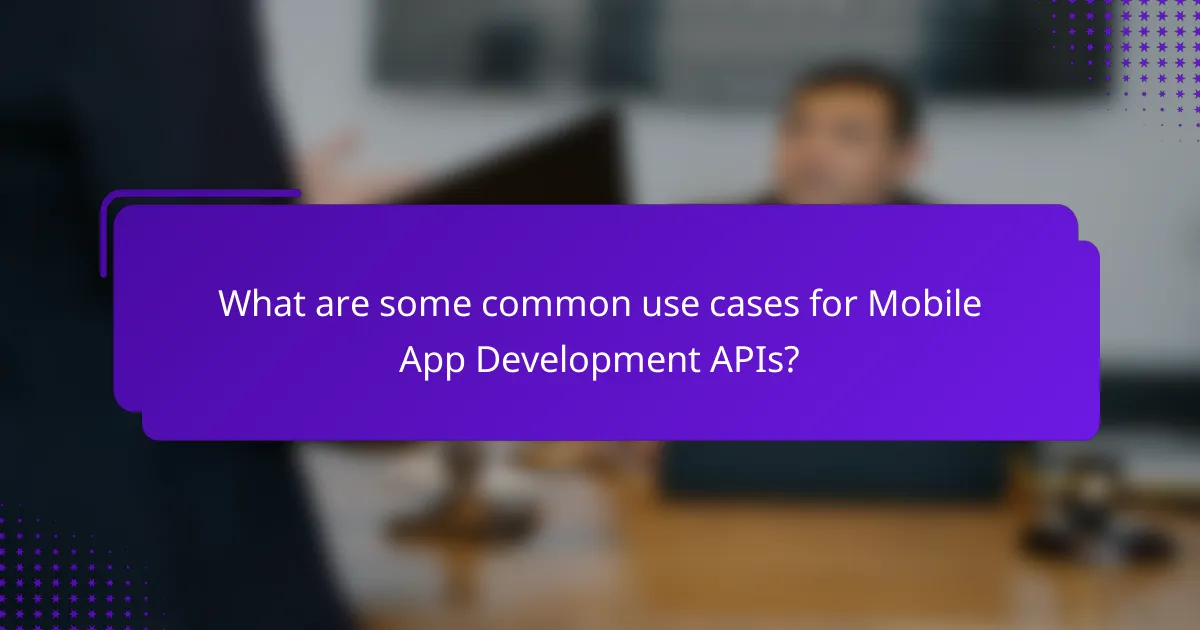
What are some common use cases for Mobile App Development APIs?
Common use cases for Mobile App Development APIs include user authentication, data integration, and payment processing. User authentication APIs allow apps to securely manage user identities. This enhances security and user experience. Data integration APIs enable apps to connect with external data sources. They facilitate real-time data access and updates. Payment processing APIs streamline transactions within mobile apps. They support various payment methods and enhance user convenience. Additionally, social media APIs allow apps to integrate sharing features. This increases user engagement and app visibility. Mapping APIs provide location-based services for navigation and geolocation features. These use cases demonstrate the versatility and importance of APIs in mobile app development.
How are APIs utilized in social media applications?
APIs are utilized in social media applications to facilitate data exchange and integration between different services. They enable features like user authentication, content sharing, and real-time messaging. For example, social media APIs allow applications to access user profiles and post updates on behalf of users. This integration enhances user experience by providing seamless connectivity with other platforms. Additionally, APIs support analytics and advertising functionalities, allowing developers to track engagement metrics and serve targeted ads. According to a report by Statista, 90% of social media marketers use APIs for data integration, highlighting their importance in the industry.
What APIs are commonly used for payment processing?
Common APIs used for payment processing include Stripe, PayPal, Square, and Braintree. Stripe offers a robust API for online transactions and supports various payment methods. PayPal’s API allows for easy integration with e-commerce platforms and mobile applications. Square provides APIs for in-person and online payments, focusing on small businesses. Braintree, a PayPal service, enables seamless transactions across multiple platforms. These APIs are widely adopted due to their security features and ease of use in mobile app development.
How do mapping APIs enhance location-based services?
Mapping APIs enhance location-based services by providing precise geographical data and functionalities. They enable developers to integrate maps, geolocation, and routing features into applications. Users benefit from real-time navigation and location tracking. Mapping APIs also support location search and geocoding, transforming addresses into coordinates. This functionality is crucial for applications in delivery, travel, and logistics. According to a 2021 report by Statista, 67% of mobile app users value location-based services. Enhanced user experiences lead to higher engagement and satisfaction. Mapping APIs thus play a vital role in the effectiveness of location-based services.
What are the future trends in Mobile App Development APIs?
Future trends in Mobile App Development APIs include increased adoption of microservices architecture. This allows for more scalable and flexible application development. Additionally, the use of GraphQL is rising due to its efficiency in data fetching. APIs are also becoming more focused on security, with enhanced authentication methods like OAuth 2.0. The integration of AI and machine learning into APIs is expected to grow, enabling smarter applications. Furthermore, the trend towards serverless architecture is gaining momentum, reducing the need for server management. Finally, the emphasis on cross-platform development is increasing, promoting the use of APIs that work seamlessly across different devices. These trends reflect the evolving landscape of mobile app development, driven by user demands and technological advancements.
How is artificial intelligence influencing API development?
Artificial intelligence is significantly influencing API development by enhancing automation and improving user experience. AI algorithms can analyze large datasets to optimize API performance. This leads to faster response times and reduced downtime. Machine learning models can predict usage patterns, allowing for better resource allocation. Additionally, AI can facilitate the creation of more intuitive and adaptive APIs. Natural language processing enables developers to create APIs that understand user intent more effectively. Furthermore, AI-driven analytics can provide insights into API usage, helping developers make informed decisions. Overall, AI integration is making APIs more efficient and user-friendly.
What advancements are expected in API security measures?
Advancements in API security measures are expected to focus on enhanced authentication methods and improved encryption protocols. Multi-factor authentication will likely become standard, adding layers of security beyond passwords. Machine learning will be leveraged to detect anomalies in API traffic, identifying potential threats in real-time. Additionally, automated security testing tools will gain traction, allowing for continuous monitoring and vulnerability assessments. API gateways will evolve to provide better traffic management and security enforcement. The adoption of OAuth 2.1 will streamline authorization processes while improving security. These advancements aim to combat increasing cyber threats and ensure data integrity.
What tips can developers follow for successful API integration?
Developers should follow best practices for successful API integration. First, they must thoroughly understand the API documentation. Clear documentation helps developers know how to use the API effectively. Next, they should implement error handling to manage unexpected responses. This ensures the application remains stable during failures. Developers should also use versioning to maintain compatibility with future API updates. This practice prevents breaking changes from affecting the application. Additionally, they must test the API integration in various scenarios. Testing helps identify potential issues before deployment. Finally, developers should monitor API performance post-integration. Continuous monitoring allows for quick identification of any problems that arise.
Mobile App Development APIs are application programming interfaces that enable developers to integrate various functionalities within mobile applications, facilitating access to external services and enhancing user experience. This article covers the different types of APIs, including REST, SOAP, and GraphQL, and discusses their key components, integration methods, and security practices. It also highlights the benefits of using APIs, such as cost savings and improved app functionality, along with common use cases across industries like healthcare and e-commerce. Additionally, the article explores future trends in API development, including advancements in security measures and the influence of artificial intelligence.
